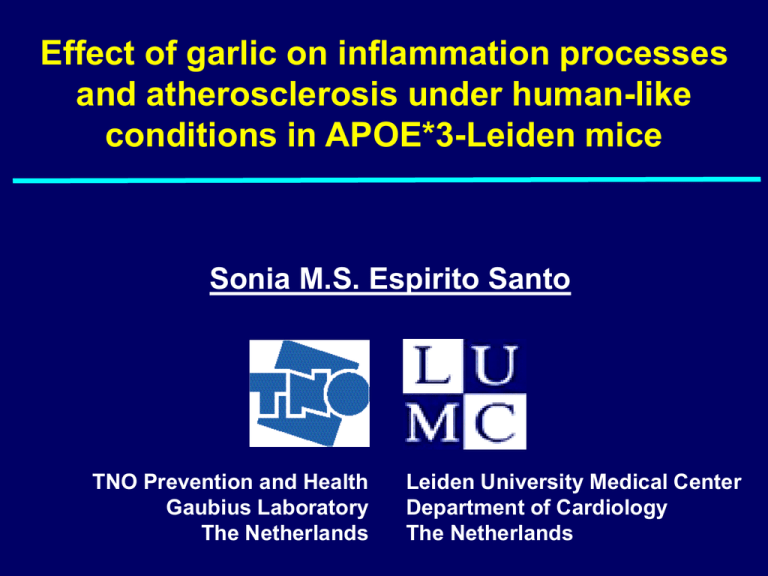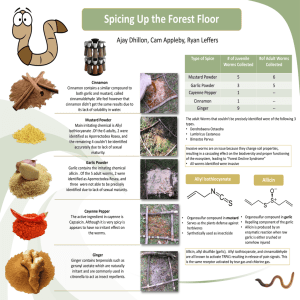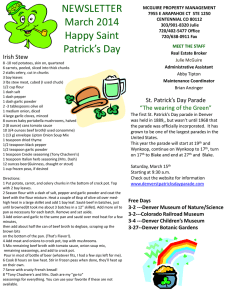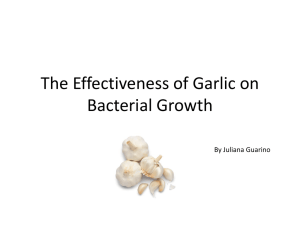Effect of garlic on inflammation processes
advertisement

Effect of garlic on inflammation processes and atherosclerosis under human-like conditions in APOE*3-Leiden mice Sonia M.S. Espirito Santo TNO Prevention and Health Gaubius Laboratory The Netherlands Leiden University Medical Center Department of Cardiology The Netherlands European Comunity Garlic and Health project • • • • Development of high quality garlic under standardized conditions. Develop of a chemically well-characterized garlic material. Define organo-sulfur compounds metabolic pathway in the clove and in vivo after ingestion. Study in vitro and in vivo the influence of this standardized and well-characterized garlic material on atherosclerosis and cancer for disease prevention. Garlic and health • • Garlic has an historical record for its use in medicine. Some studies have suggested that garlic significantly reduces plasma lipid levels, systolic and diastolic blood pressure and that shows a strong antibiotic activity. Kik C, Kahane R, Gebhardt R. Nutr Metab Cardiovasc Dis. 2001;11:57-65. • Garlic clinical trials and animal studies with wellcharacterized and standardized garlic material, with a consistent study design and dosage are poorly found in the last 15 years. Possible effects of garlic on lipid metabolism LDL LIVER LDL receptor UPTAKE SYNTHESIS other receptors CHOLESTEROL STORAGE CHOLESTERYL ESTERS VLDL CONVERSION SECRETION BILIARY CHOLESTEROL BILE ACIDS BILE CM Remnants INTESTINE DIETARY CHOLESTEROL CM Possible effects of garlic on atherosclerosis Shear stress Intima Inflammation Oxidation Monocytes Media Fibrous cap LDL Thrombus Endothelium oxLDL O2 Lipid core Collagen- degrading proteinases Contradictory effects attributed to garlic • Old human trials on healthy patients treated with garlic oil reported a decrease in plasma lipid levels. Bordia A, et al. Atherosclerosis.1975;21:15-19. Bordia A, et al. • Recent human trials on hypercholesterolemic patients showed no effects of garlic powder (Kwai) and garlic oil treatment on plasma lipid levels. Simmons LA, et al. Atherosclerosis.1994;113:219-225. Berthold, et al. JAMA. 1998;279:1900-02. McCrindle BW, et al. Arch Pediatr Adolesc Med. 1998;152:1089-94. Isaacsohn JL, et al. Arch Intern Med.1998;158:1189-94. Gardner CD, et al. Atherosclerosis. 2001;154:213-220. Ziaei S, et al. Eur J Obstetrics & Gynecology. 2001;99:201-6. • Allicin showed no effects on plasma lipid levels and decreased aortic fatty streaks-like lesions in hypercholesterolemic C57Black/6 mice. D. Abramovitz et al., Coronary Artery Disease, 1999, 10: 515-519. • Induced-atherosclerosis in rabbits fed garlic oil and aged garlic extract (Kyolic) showed a decrease of aortic fatty streaks lesions. Bordia A, et al. 1980:428-37. Mand JK, et al. Indian Heart J. 1985;37:183-88. Efendy JL, et al. Atherosclerosis. 1997:132:37-42. Campbell JH, et al. J Nutr. 2001;131:1006S-09S. Durak I, et al. Nutr Metab Cardiovasc Dis. 2002 ;12:141-7. • Hypercholesterolemic pigs and rats fed garlic oil and garlic powder (Kwai) showed no effects on atherosclerosis development. Heinle H,et al. Drug Res. 1994;44:614-17. Lee WM, et al. Exper Mol Pathol. 1980:33:345-8. Previous reported effects of garlic (LI111, Morado 200, Allicin and DADS) in APOE*3Leiden mice • Lipid metabolism - No effects of garlic powders and isolated compounds on plasma lipid levels and markers of cholesterol synthesis and absorption under hyperlipidemic conditions. - • Morado 200 garlic powder showed an improved liver function, decreased plasma cholesterol levels and serum amyloid A levels under atherogenic conditions. Fast atherosclerosis development – No decreasing effect of garlic on atherosclerosis of the aortic root was observed for all treatments. Espirito Santo SMS, et al. Effect of garlic powders and garlic isolated compounds on lipid metabolism. 2002. Effect of garlic on inflammation processes and atherosclerosis under human-like conditions: Aim Study the effect of 2 different doses of Printanor garlic powder • • • under mild human-like conditions on inflammation related parameters on atherosclerosis development by means of a hyperlipidemic and atherosclerosissusceptible APOE*3-Leiden transgenic mice. Effect of garlic on inflammation and atherosclerosis under human-like conditions: Garlic powders • • • Printanor FR 2001 (0.5% Prin): 0.5% of dry garlic powder with low sulphur content. Printanor FR 2001 (5% Prin): 5% of dry garlic powder with high sulphur content. Kyolic (positive control): 0.16% of dry garlic powder rich in S-allylcysteine reported to result in 64% reduction of fatty streaks in New Zealand white rabbits. Campbell JH, Efendy JL, et al. J.Nutrition. 2001;131:1006S-1009S. Effect of garlic on inflammation and atherosclerosis under human-like conditions: Experimental design 16 female APOE*3-Leiden mice per group 0.2% cholesterol diet for 28 weeks • • • General parameters: Body weight, food intake, marker of liver function, plasma lipid levels, blood pressure, and fecal fatty acids. Inflammation related parameters: All body and vessel wall inflammation markers (Serum amyloid A, soluble ICAM, and von willebrand factor) and whole blood stimulation assay. Atherosclerosis related parameters: Aortic root lesions typing, and total lesion area. Body weight gain (g) Effect of garlic on body weight gain of APOE*3-Leiden mice Control 0.5%Prin 10 8 6 4 2 0 Control 5% Prin * * * * 0 4 8 12 16 20 24 0 4 8 12 16 20 24 Control Kyolic * 0 4 8 12 16 20 24 28 Weeks P<0.01 Effect of garlic on food intake and body temperature of APOE*3-Leiden mice Food intake (g/mouse/day) Free fatty acids (mM) Control 2.79 ± 0.08 0.73 ± 0.13 0.5% Prin 2.87 ± 0.12 0.79 ± 0.11 5% Prin 2.75 ± 0.16 0.60 ± 0.10 Kyolic 2.88 ± 0.10 0.62 ± 0.18* * Total dry feces (g/ day) 5 * 4 3 2 1 0 Control 0.5% Prin 5% Kyolic Prin Total fat excretion (µmol/100g mouse/day) Effect of garlic on fecal fatty acids excretion of APOE*3-Leiden mice 800 * 600 400 200 0 Control 0.5% Prin 5% Kyolic Prin P<0.05 Plasma ALAT levels (U/L) Effect of garlic on liver function of APOE*3-Leiden mice Control 0.5%Prin Control 5% Prin Control Kyolic 200 150 100 50 0 0 4 8 12 16 20 24 0 4 8 12 16 20 24 Weeks 0 4 8 12 16 20 24 28 Cholesterol levels (mM) Effect of garlic on plasma cholesterol levels of APOE*3-Leiden mice Control 0.5%Prin Control 5% Prin Control Kyolic 20 15 10 5 0 0 4 8 12 16 20 24 0 4 8 12 16 20 24 Weeks 0 4 8 12 16 20 24 28 Triglycerides levels (mM) Effect of garlic on plasma triglyceride levels of APOE*3-Leiden mice Control 0.5%Prin Control 5% Prin Control Kyolic 4 3 2 1 0 0 4 8 12 16 20 24 0 4 8 12 16 20 24 Weeks 0 4 8 12 16 20 24 28 Effect of garlic on lipoprotein profile of APOE*3-Leiden mice Before treatment with garlic preparations 2 Control 0.5% Prin 5% Prin Kyolic 1 mM 0 0 8 16 24 0 8 16 24 0 8 16 24 0 8 16 24 8 16 24 0 8 16 24 0 Triglycerides Cholesterol Fractions 8 16 24 After treatment with garlic preparations 2 1 0 0 8 16 24 0 Blood pressure (mmHg) Effect of garlic on blood pressure of APOE*3-Leiden mice 160 12 weeks 16 weeks 120 80 40 0 Control 0.5% Prin 5% Kyolic Control 0.5% 5% Kyolic Prin Prin Prin SAA (µg/ml) Effect of garlic on serum SAA and ICAM levels of APOE*3-Leiden mice Control 0.5%Prin 20 Control 5% Prin Control Kyolic 15 10 5 ICAM (µg/ml) 0 0 4 8 12 16 20 24 0 4 8 12 16 20 24 0 4 8 12 16 20 24 28 0 4 8 12 16 20 24 0 4 8 12 16 20 24 0 4 8 12 16 20 24 28 40 30 20 10 0 Effect of garlic on plasma vWF levels of APOE*3-Leiden mice vWF (% PP rat) Control 0.5%Prin 250 200 150 100 50 0 0 4 8 12 16 20 24 Control 5% Prin 0 4 8 12 16 20 24 Control Kyolic 0 4 8 12 16 20 24 28 Effect of garlic on atherosclerosis development of APOE*3-Leiden mice Lesion area Type I-III Type IV-V 250 100 Control 0.5% 5% Kyolic Prin Prin 80 60 40 20 200 µm2 1000 500 400 300 200 100 0 Lesion typing % mM Cholesterol exposure 150 100 50 0 Control 0.5% 5% Kyolic Prin Prin 0 Control 0.5% 5% Kyolic Prin Prin Cholesterol exposure (mM) Correlation between cholesterol exposure and atherosclerosis lesion area after garlic treatment of APOE*3-Leiden mice 600 Y= 0.8308x + 289.82 R= 0.8136 400 200 0 0 50 100 150 Area (µm2 1000) 200 Conclusions Dietary garlic treatment on APOE*3-Leiden mice results in: • • • Decreased body weight gain (P=0.007) for the 5% Printanor treated group: – lower (P=0.032) plasma free fatty acids – higher (P=0.043) fecal fatty acids excretion No effects on liver function, plasma lipids and glucose levels, and on blood pressure. No effects on markers of all body and vessel wall inflammation and on atherosclerosis development. Future perspectives Human intervention study Collaboration with CHDR-Leiden Ackowledgements Sonia Espirito Santo Wim van Duyvenvoorde Erik Offerman Ria van den Hoogen Louis Havekes Hans Princen Bart van Vlijmen






